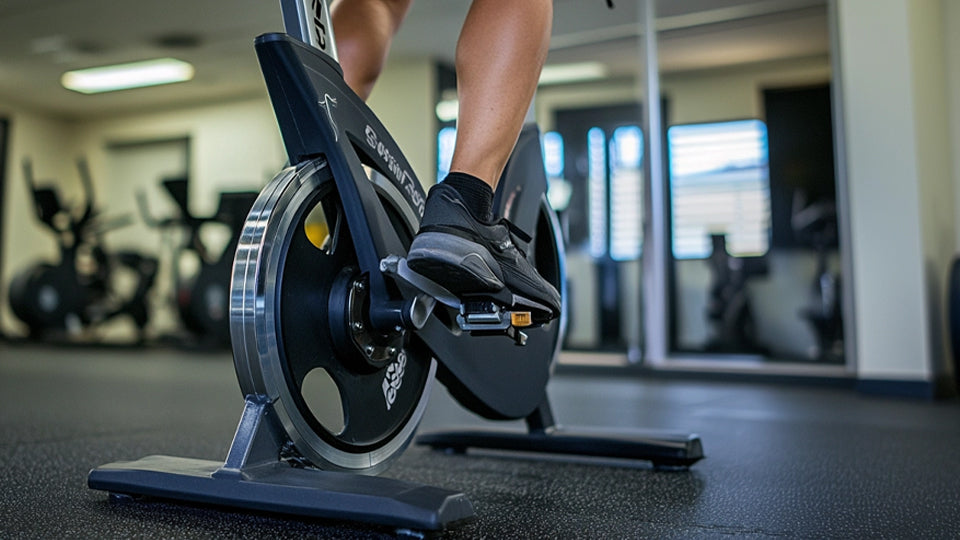Completing an FTP Test Will Improve Your Training

Is an FTP test every cyclist’s most-hated workout? Yes. But it’s done for good reasons! Regardless of how often you compete in races, knowing your FTP can help you target more accurate zones during workouts, which allows you to increase strength and speed on the bike while avoiding illness and injury. In this article, we’ll cover how to conduct an FTP test effectively and go over the benefits it can bring to your cycling performance.
What is FTP?
Functional Threshold Power (FTP) is the maximum power output you can sustain for approximately one hour. It serves as a proxy for your anaerobic threshold, the point at which lactic acid begins to accumulate in your bloodstream faster than it can be removed. Establishing an accurate FTP is essential for creating personalized training zones, which in turn allows for more effective workouts.
Why Test FTP?
Testing your FTP regularly is key to tracking your progress and adjusting your training plan. By knowing your FTP, you can:
- Narrow Down Training Zones: Establishing power zones based on your FTP helps you tailor your workouts to specific energy systems
- Avoid Overtraining: Monitoring your FTP ensures you're training at the right intensity, reducing the risk of burnout, illness, and injury
- Measure Progress: Frequent testing allows you to see improvements over time, giving you a motivation boost
Preparing for the FTP Test
1. Choose Your Test Method
There are several ways to conduct an FTP test, but the most popular methods include:
- 20-Minute Test: After a proper warm-up, ride as hard as you can for 20 minutes
- Ramp Test: This involves gradually increasing the intensity at five-minute intervals until failure
- 8-Minute Test: Perform two 8-minute maximal efforts with a 10-minute rest in between
2. Location, Location, Location
For any FTP test, you’ll want to find a flat road or a moderate climb (3-5% gradient) so that your power numbers aren’t jumping all over the place. For most cyclists, it’s easiest to complete the test indoors, on a stationary trainer so you don’t have to worry about traffic, intersections, pedestrians, or gradient changes and can focus solely on the effort.
3. Get the Right Gear
Regardless of where or how you complete an FTP test, you’ll want to use a bike with a computer and power meter set up on it. Depending on what you’re looking for and what kind of bike you’re using, you can get a power meter that’s in the rear hub, crank arm(s), or even the pedals. Just about any bike computer with GPS technology will be able to connect with your power meter of choice.
Additional equipment that can be helpful during your test is a towel for sweat, a bottle of water, and music. Make sure you have everything with you before you start so you don’t need to interrupt the test, thus invalidating it.
4. Fuel Right
Fuel your body adequately before your FTP test. Aim for a carbohydrate-rich snack 30 minutes prior like a peanut butter sandwich, rice cakes with honey drizzled on top, or a bagel. Staying hydrated is equally important, so drink water or an electrolyte mix leading up to your effort.
5. Warm Up Properly
If you try to do an FTP test with cold legs, you will suffer greatly and not get an accurate result. Therefore, a thorough warm-up is crucial. Spend at least 20 minutes spinning and incorporate a few short, high-intensity efforts to get your muscles (and lungs!) ready for the test. You should be breathing hard and breaking a sweat by the end of your warm up.
Pacing Strategy
For the 20-minute test, break the effort into smaller segments. Consider pacing yourself by aiming for a slightly lower wattage for the first few minutes, then gradually increasing. Avoid starting too hard, as this can lead to premature fatigue. For the ramp test, focus on maintaining the target power for all five minutes. Push until your legs and lungs give out.
Regardless of which test you complete, pay attention to your rate of perceived exertion (RPE). This subjective measure can help you gauge whether to push harder or hold steady. Aim to finish the test completely exhausted — you should feel so physically wrecked that you need to lay down on the floor and catch your breath.
Calculating Your FTP
Once you've completed the test, it’s time to calculate your FTP:
- 20-Minute Test: Take your average power for the 20 minutes and multiply by 0.95
- Ramp Test: Use the power output at the last completed stage
- 8-Minute Test: Calculate 90% of the average power from both efforts
Setting Training Zones
With your FTP calculated, you can now set your training zones. Here’s what most cyclists use:
- Zone 1 (Active Recovery): < 55% of FTP
- Zone 2 (Endurance): 56-75% of FTP
- Zone 3 (Tempo): 76-90% of FTP
- Zone 4 (Lactate Threshold): 91-105% of FTP
- Zone 5 (VO2 Max): 106-120% of FTP
- Zone 6 (Anaerobic Capacity): 121%+ of FTP
Best Practices for FTP Testing
- Test Regularly: Schedule your FTP tests every 4-6 weeks to monitor progress and adjust your training.
- Be Consistent: Use the same conditions for each test to ensure comparability. This includes the same bike, power meter, and location.
- Prioritize Recovery: Ensure you’re well-rested before the test. Testing while fatigued can lead to inaccurate results.
- Fuel and Hydration: Consistent nutrition and hydration practices will help you achieve your best performance.
Conducting an FTP test is a fundamental practice for any semi-competitive cyclist looking to elevate their training. By understanding what FTP is, how to accurately test it, and how to apply the results to your training zones, you can make informed decisions that will enhance your day-to-day workouts and improve your fitness overall. Regular testing not only helps you track progress but also keeps you motivated as you see your hard work pay off! Embrace the challenge, and let it rip during your next (or first!) FTP test!
Take the next step in your training regimen: Try any BRL Sports supplement risk-free! If our natural nutritional products aren’t the best you’ve ever used, simply return your purchase for a 100% refund — no questions asked!
Also in Inspiration & Perspiration

High Altitude Supplements: Complete Guide to Training & Prevention (Altitude Sickness Solutions)
Support endurance and reduce altitude stress with supplements that improve oxygen efficiency, stamina, and recovery in high-altitude conditions.

Best Supplements For Runners: Complete Guide By Training Phase (Base, Peak, Taper & Race Day)
Discover the best supplements for runners by training phase—base, peak, taper, and race day—to boost endurance, recovery, and performance.

Creatine for Endurance vs. Sprint Efforts
Creatine isn’t just for power—learn how it boosts sprint speed, recovery, and endurance performance.


